Khao Pad: Your Ultimate Guide to Authentic Thai Fried Rice
Embark on an epicurean adventure to the vibrant streets of Thailand with this incredible Khao Pad recipe. Known globally as Thai Fried Rice, this dish is not just food; it’s a celebration of fresh flavors, aromatic spices, and a cornerstone of Thai culinary tradition. Our easy-to-follow recipe brings the essence of Bangkok’s bustling markets right into your kitchen. It’s flavor-packed, surprisingly healthy, and wonderfully simple to prepare, especially perfect for giving leftover rice a delicious new life. Get ready to transform your weekday meals into a fresh, nutritious, and deeply satisfying experience.
Prepare to delight your taste buds, stay within your budget, and save precious time by making this Khao Pad recipe a cherished staple in your culinary repertoire. It’s more than just a meal; it’s an invitation to explore the rich tapestry of Thai cuisine with minimal effort and maximum reward.
What is Khao Pad? Unraveling the Delights of Thai Fried Rice
Khao Pad, which literally translates to “stir-fried rice” in Thai, is a universally beloved dish that has transcended its origins as humble street food to become a global culinary icon. Deeply rooted in the cultural fabric of Thailand, it has enchanted generations of food lovers with its captivating blend of textures and tastes. From the bustling hawker stalls of Bangkok to upscale Thai restaurants across the globe, Khao Pad remains a testament to the delicious and aromatic essence of Thai cuisine.
At its heart, Khao Pad is a delightful stir-fried medley, typically featuring perfectly cooked jasmine rice, fresh vegetables, scrambled eggs, and a customizable array of seasonings. What makes this dish truly special is its incredible versatility. It allows you to effortlessly tailor it to your personal flavor preferences, adding anything from succulent shrimp to tender chicken or a medley of your favorite greens. Beyond its adaptability, Khao Pad is renowned for its quick preparation time, often coming together in a mere 15 minutes, making it an ideal choice for a speedy yet satisfying meal.
If you’re seeking more lightning-fast dinner solutions, be sure to explore other quick recipes like these easy pea fritters, offering another fantastic option for a busy schedule.
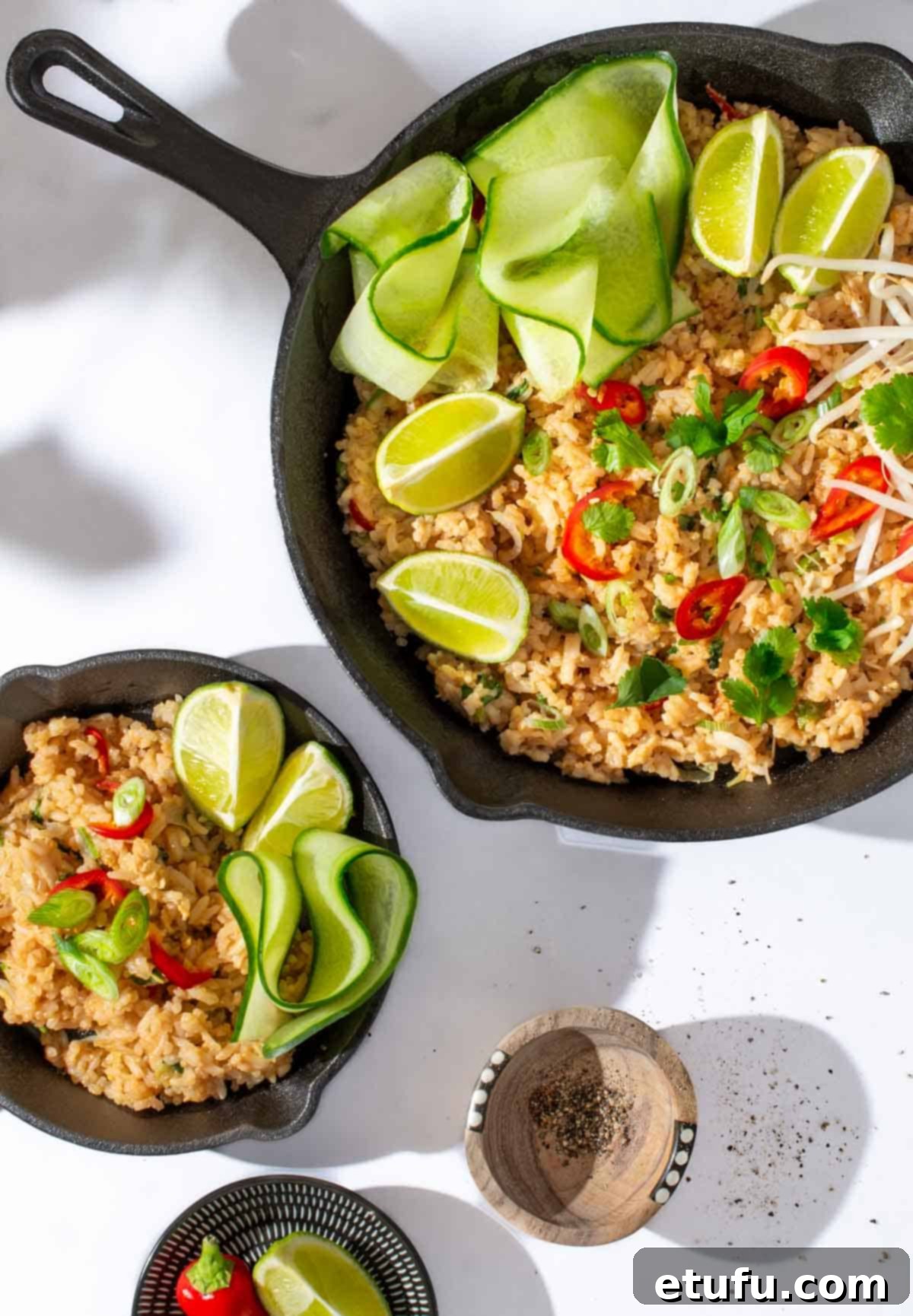
Thailand – A Glimpse into the Land of Smiles
Before we dive deeper into the flavors of Thailand, here are some quick facts about the enchanting country that gave us Khao Pad:

| Location | Thailand is strategically located in Southeast Asia, sharing borders with Myanmar (Burma) to the west, Laos to the north and east, Cambodia to the southeast, and Malaysia to the south. Its diverse geography ranges from mountainous regions to pristine coastlines. |
| Language | The official language of Thailand is Thai, a tonal language known for its unique script. It’s a beautiful language that reflects the country’s rich heritage and traditions. |
| Population | Home to approximately 69 million people, Thailand boasts a diverse population with a vibrant culture and strong sense of community. |
| Trivia | Thailand is famously known as the “Land of Smiles,” a moniker it earned due to the genuinely friendly, warm, and welcoming nature of its people, who greet visitors with genuine hospitality. |
Why You’ll Adore This Khao Pad Recipe
This authentic Thai fried rice recipe isn’t just another dish; it’s a kitchen hero waiting to happen. Here’s why it will quickly become a cherished favorite:
- Speedy Preparation: Bid farewell to long cooking times! This delightful stir-fry can be whipped up in 15 minutes or less, making it the perfect solution for busy weeknights when you crave something delicious without the fuss.
- Clever Use for Leftover Rice: Don’t let perfectly good rice go to waste. This recipe is an excellent way to utilize day-old rice, transforming it into a fresh, flavorful, and entirely new meal, minimizing food waste and maximizing taste.
- Nutritious and Wholesome: Packed with essential vitamins, minerals, and nutrients, Khao Pad is a healthy choice that keeps you energized throughout your day. It’s a balanced meal that doesn’t compromise on flavor.
- Endless Vegetable Customization: The beauty of Khao Pad lies in its adaptability. Feel free to add your favorite vegetables, from crunchy carrots and vibrant bell peppers to crisp snap peas or Chinese broccoli, making it unique every time.
- Tailor Your Spice Level: Whether you prefer a gentle warmth or a fiery kick, you have complete control over the heat in this dish. Adjust the amount of chili to suit your palate. For those eager to delve deeper into the world of flavor, our informative Spice charts offer fascinating insights into various spices.
- Protein Powerhouse Options: Easily transform this vegetarian base into a hearty meal by incorporating your preferred protein. Sautéed chicken strips, tender beef strips, succulent shrimp, flaky salmon, or crispy tofu are all fantastic additions that elevate the dish.
Essential Ingredients and Clever Substitutions for Khao Pad
Crafting the perfect Khao Pad begins with understanding its core components. While simplicity is key, selecting the right ingredients—and knowing when to make smart substitutions—will elevate your dish from good to truly exceptional.
**For the complete recipe and detailed ingredients list, please refer to the recipe card at the bottom of this post.**
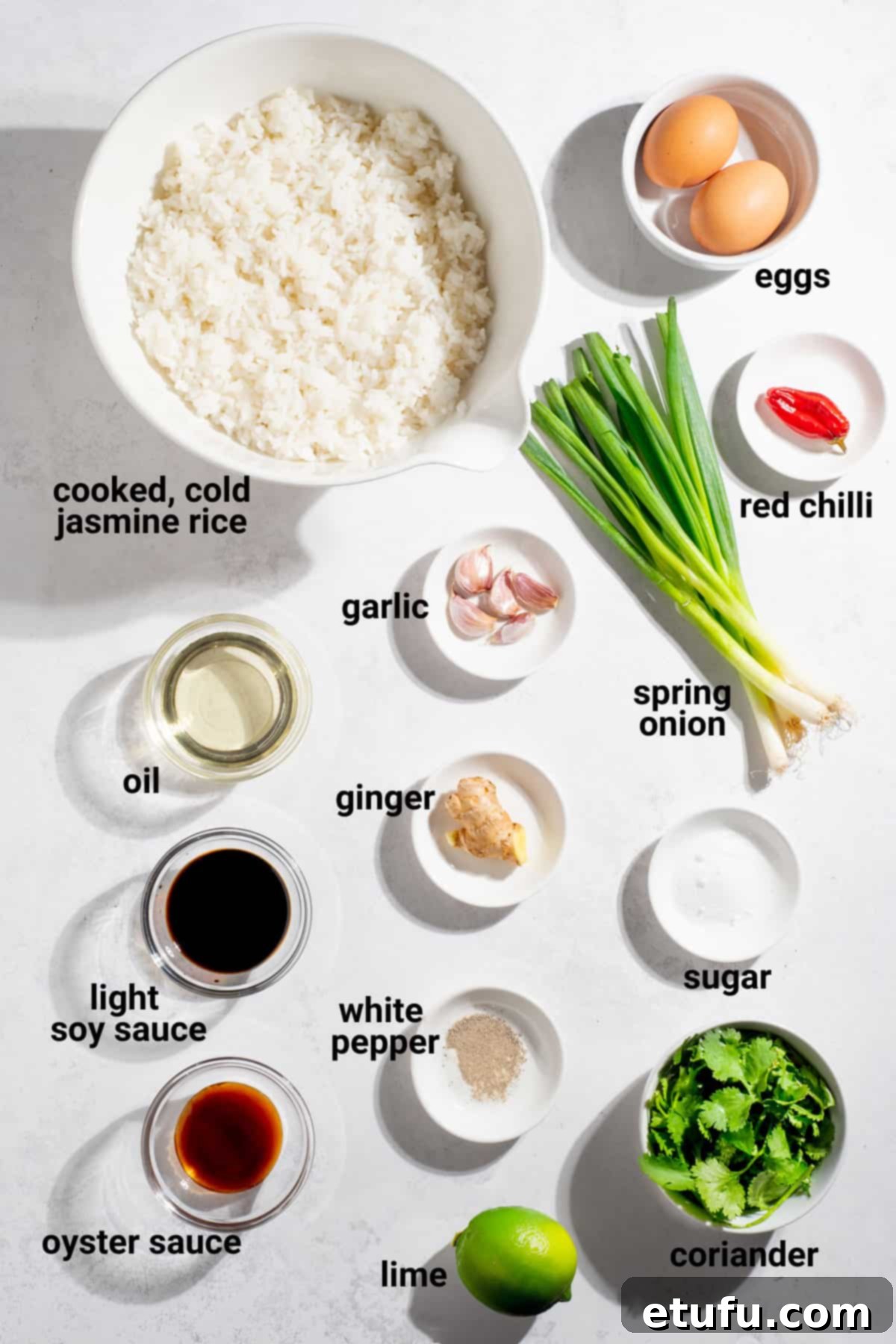
Thai Jasmine Rice: The Heart of Khao Pad
The foundation of any great Khao Pad is the rice, and traditionally, leftover white rice from the day before is the ultimate choice. Its slightly dry, firm texture is ideal for stir-frying, preventing the dish from becoming mushy. While you can cook rice specifically for this recipe, ensure it is thoroughly chilled and rested before use.
Fragrant, medium-grain Jasmine rice is the undisputed champion for Thai fried rice. Its unique aroma and perfect balance of tenderness and chewiness provide the ideal consistency and flavor profile for Khao Pad. Short-grain rice varieties often become too sticky and clumpy, while long-grain options like Basmati can sometimes result in a fried rice that’s too dry. Jasmine rice perfectly strikes that coveted balance.
However, don’t let tradition stifle your creativity! While Jasmine rice is highly recommended, feel free to experiment with other types of rice if you have a preference or dietary restrictions. The most crucial factor remains using cold, day-old rice.
Why Use Cold, Day-Old Rice?
This isn’t just a recommendation; it’s a golden rule for superior fried rice. Cold, leftover rice contains less moisture than freshly cooked rice, which is paramount for achieving those distinct, perfectly separated grains that characterize authentic fried rice. Using warm, freshly cooked rice almost guarantees a sticky, clumpy, and unappetizing result. Cold rice also breaks up more easily in the pan, ensuring even distribution of flavors and a superior texture.
Essential Flavorings: Aromatic Base
Our recipe calls for finely chopped garlic, freshly grated ginger, white pepper, and fresh coriander leaves to build a robust and aromatic flavor base. These ingredients are fundamental to the Thai flavor profile.
If you’re pressed for time, good quality garlic and ginger pastes can serve as convenient substitutes. However, for the most authentic and vibrant flavor, investing a few extra minutes to use fresh garlic and ginger is highly recommended. The difference in aroma and depth is noticeable. White pepper, with its subtler heat and distinct pungency, is traditional, but black pepper can be used as a readily available alternative without significantly altering the dish’s character.
The Sauce Symphony: Soy and Oyster Sauce
There’s an art to balancing the sauces in fried rice, and no single “correct” combination exists. Traditionally, the Thai fried rice sauce trinity often involves a harmonious blend of light soy sauce, fish sauce, and/or oyster sauce. The precise proportions are often a matter of the chef’s personal touch and regional variations.
In this particular recipe, we lean towards the rich, savory depth of oyster sauce, which contributes a glossy texture and umami complexity. However, if you prefer, fish sauce can be used instead for a more pronounced salty and pungent flavor, or you can even combine all three to create a multi-layered taste experience. Feel free to adjust based on your personal preference and what you have available in your pantry.
Eggs: The Unifying Element
Jasmine rice and fried egg are both considered essential components of authentic Thai fried rice. The eggs add a lovely texture, richness, and help bind the dish together.
The key to perfect eggs in Khao Pad is to cook them until they are just set—soft and slightly moist—before introducing the rice. It’s crucial to avoid overcooking them into dry, rubbery bits. Some chefs prefer to push the other ingredients to one side of the pan, create a hollow, and then scramble the eggs directly into the empty space before incorporating them. Choose the method that you find easiest and most effective for achieving those perfectly soft, flavorful egg pieces.
Spring Onions: Freshness and Bite
Also commonly known as “green onions” in various parts of the world, spring onions contribute a delightful freshness and a subtle oniony crunch to the Khao Pad. They are added at the very end to retain their vibrant color and texture.
Our recipe typically uses about 50 grams, which amounts to roughly 3-4 medium spring onions, utilizing both their white and green parts. However, feel free to adjust the quantity to your liking; some enjoy a generous amount for a bolder flavor, while others prefer a lighter touch. They truly brighten up the dish and add a lovely aromatic finish.
Limes: The Brightening Zest
Served in wedges on the side of your Khao Pad, a fresh squeeze of lime juice is a simple yet transformative addition. Its bright, acidic notes cut beautifully through the richness and savoriness of the sauces and the slight stickiness of the rice. This burst of citrus zest truly elevates the dish, adding a refreshing tang that balances the overall flavor profile and leaves a clean finish on the palate.
Sliced Red Chillies (Optional): Controlling the Heat
For those who appreciate a touch of heat, finely sliced red chillies are an excellent optional addition. The amount you use can be adjusted entirely to your personal taste, or they can be omitted if you prefer a milder dish. We typically use one red chili for a pleasant, mild warmth, but the intensity can vary significantly based on the size and type of chili.
It’s important to note that Thai chillies, which are typically long and thin, are generally much hotter than the shorter, plumper “generic” red chillies often found in supermarkets. If you’re using Thai bird’s eye chilies, use them sparingly or adjust according to your tolerance for spice.
Understanding Rice Yield: How Much Dry Rice for 800g Cooked?
When preparing fried rice, having the correct amount of cooked rice is crucial for optimal texture and flavor. A dependable rule of thumb for rice preparation is that dry rice generally triples in weight once cooked. Therefore, to achieve approximately 800g of cooked rice, you would need to start with roughly 270g of dry rice.
It’s always a good strategy to err on the side of caution. Rounding up to about 300g of dry rice ensures you have a little extra wiggle room, allowing for minor measurement variations. Rest assured, whether you end up with slightly more or slightly less than 800g of cooked rice, it will not significantly impact the success or deliciousness of your Khao Pad recipe. The key is to have cold, firm rice ready for stir-frying.
Crafting Perfect Khao Pad: A Step-by-Step Guide
Creating authentic Thai Fried Rice is a fast and exciting process. The key to success is having all your ingredients prepped and ready before you start cooking, a technique known as “mise en place.”
- Preparation is Key: Begin by measuring out all your sauces and finely chopping all your ingredients. Since this dish cooks very quickly over high heat, having everything within arm’s reach will ensure a smooth and enjoyable cooking experience. This prevents frantic scrambling and ensures no ingredient is overcooked or undercooked.
- Heat the Wok or Pan: In a large frying pan or a traditional wok, heat the vegetable oil over medium-high heat. Allow the pan to get adequately hot, as this is crucial for achieving that characteristic stir-fry crispness and flavor.
- Infuse with Aromatics: Add the chopped garlic and grated ginger to the hot oil. Stir-fry them quickly for about 30-60 seconds, or until you notice a few specks of garlic beginning to brown and a wonderful aroma fills your kitchen. Be careful not to burn them, as this can make the dish bitter.
- Introduce the Eggs: Gently break the eggs directly into the pan. Let them sit undisturbed for just a few seconds until their edges begin to set slightly. This initial setting helps them hold their shape a little before scrambling.
- Scramble and Cook Eggs: Using your spatula, swiftly break the eggs up into smaller pieces and move them around the pan. Work quickly to prevent them from sticking or browning too rapidly. The goal is soft, fluffy pieces of egg.
- Perfect Egg Texture: Continue cooking the eggs until they are soft-set and cooked through, but be careful not to over-scramble or dry them out. This process should take no more than 30 seconds from the moment you broke them into the pan, ensuring they remain tender and moist.
- Add Sauces and Seasoning: Now, add the measured light soy sauce, oyster sauce, white pepper, and a pinch of sugar to the pan. These liquid ingredients will quickly come together to form the flavorful coating for your rice.
- Incorporate the Rice: Immediately tip all the cold, cooked jasmine rice into the pan. Using cold rice is essential here to prevent the dish from becoming mushy.
- Stir-Fry to Perfection: Keep the heat on medium-high and work quickly, continuously moving the rice around the pan. Use your spatula to break up any clumps and thoroughly combine the rice with all the other ingredients and sauces. Continue stirring until the rice is heated through and lightly fried, achieving that slightly toasted texture.
- Final Fresh Additions: Remove the pan from the heat. Now, stir in the finely sliced spring onions, chopped fresh coriander, and the optional chopped red chili. The residual heat will warm these ingredients slightly while keeping them fresh and vibrant.
- Serve Immediately: Give your fresh additions a final stir through the rice. Serve your delicious Khao Pad immediately, accompanied by a fresh wedge of lime on the side for an optional squeeze of citrusy brightness. Enjoy this authentic taste of Thailand!
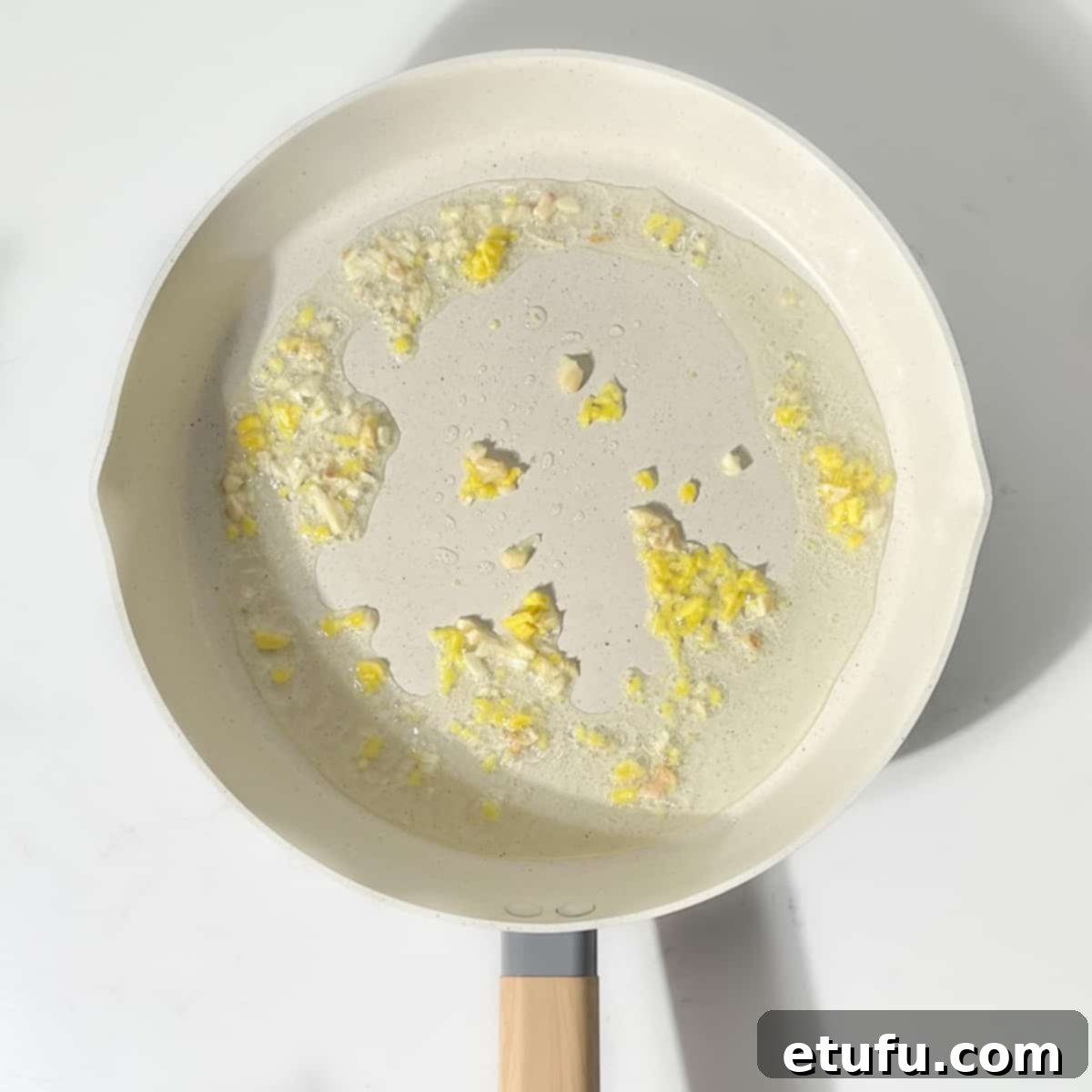
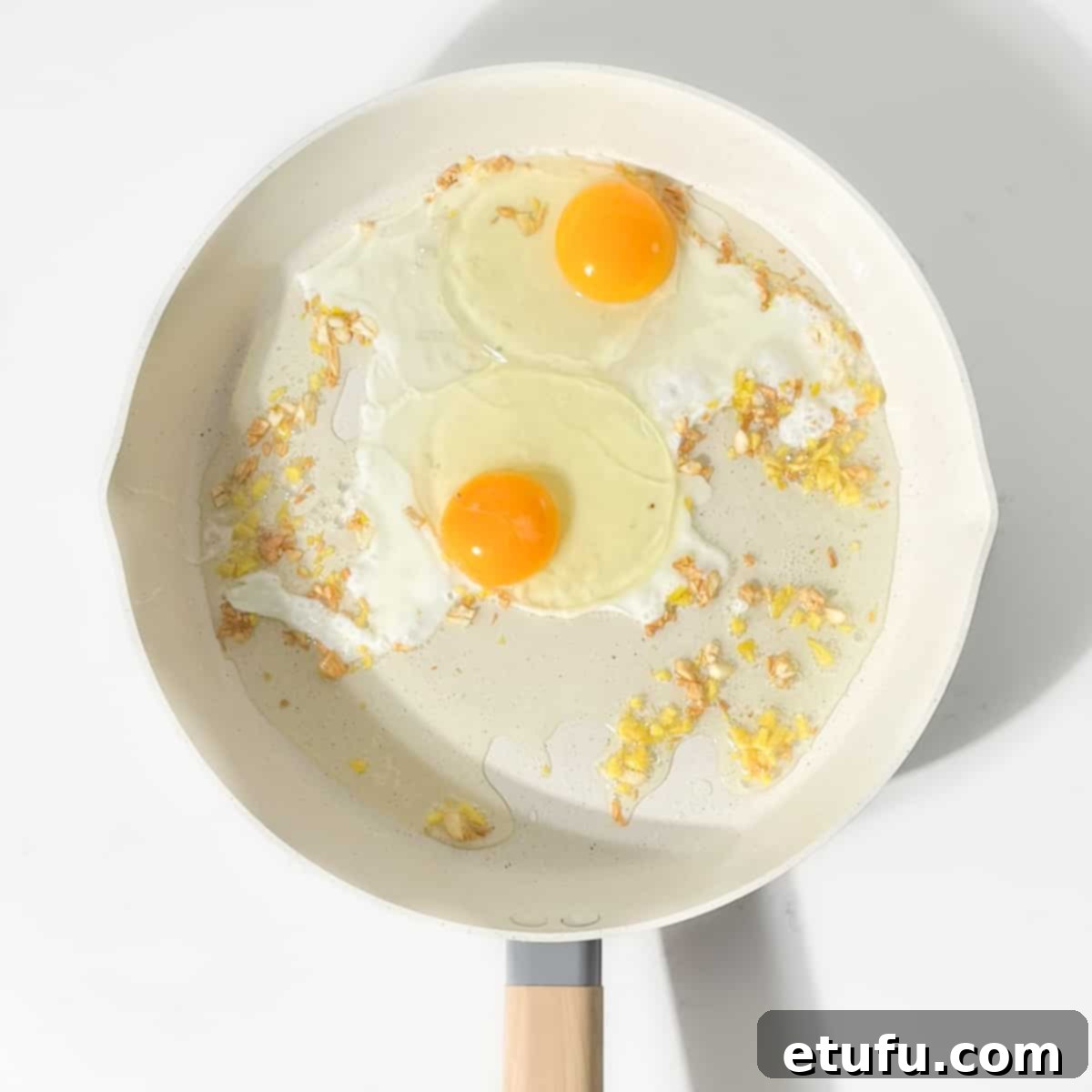
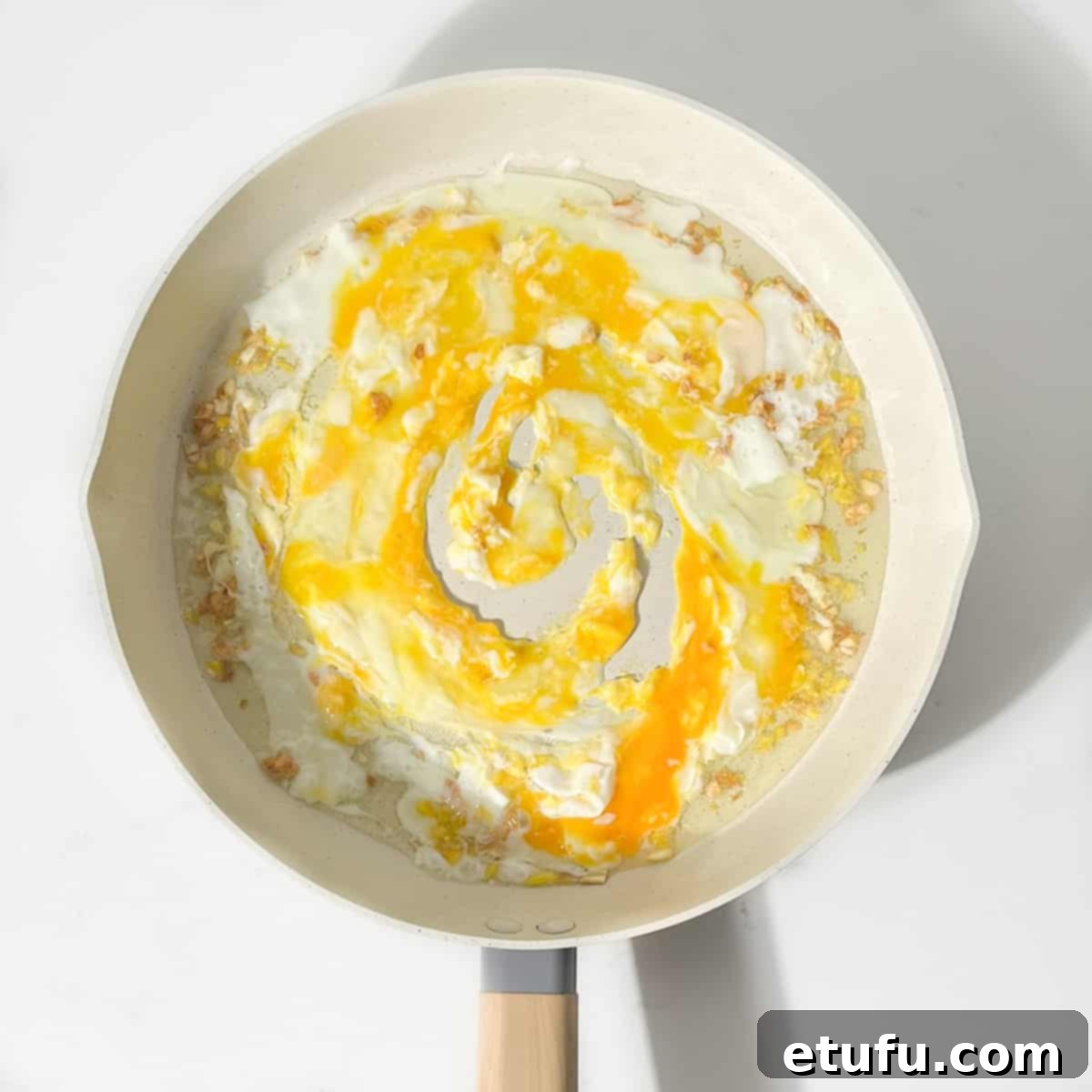
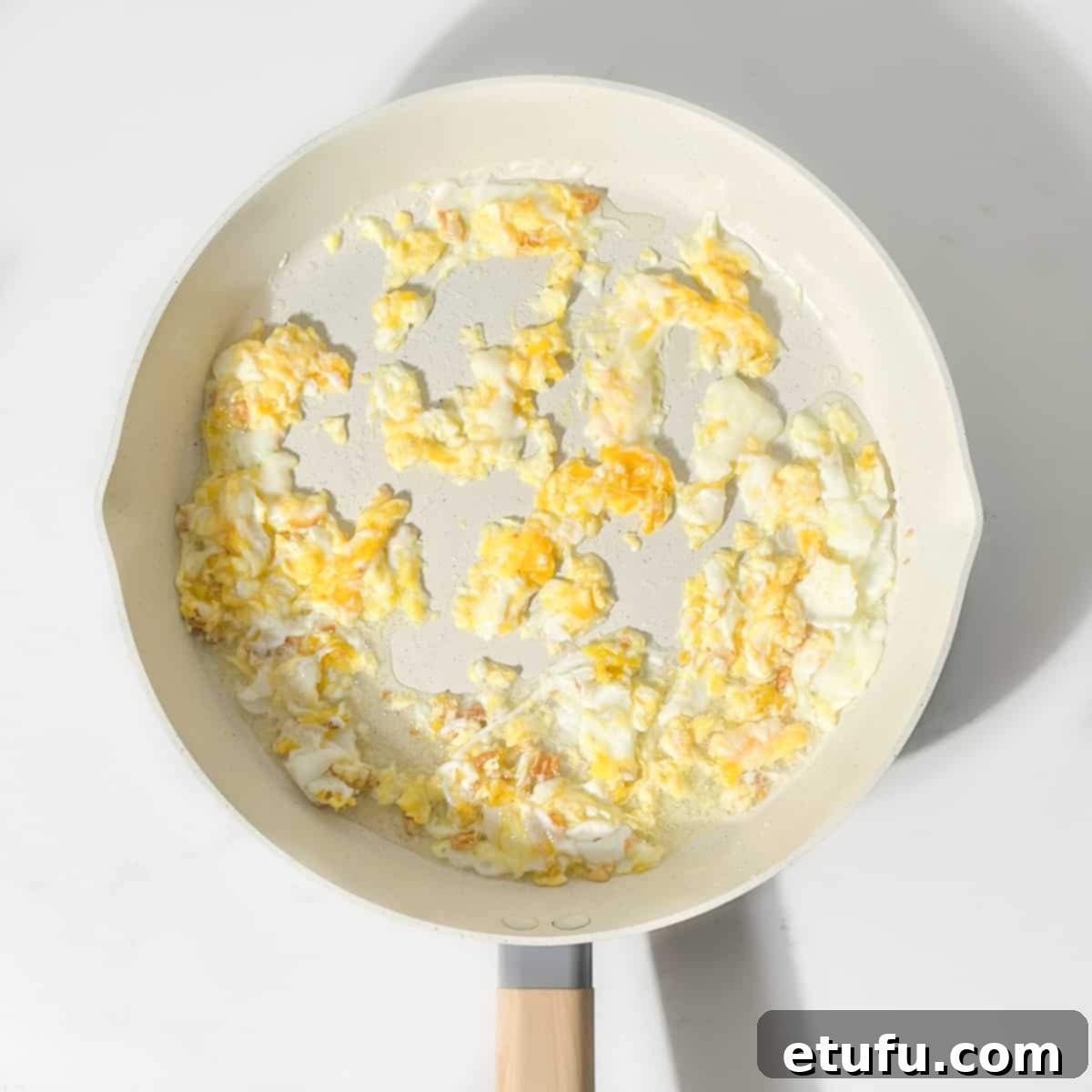

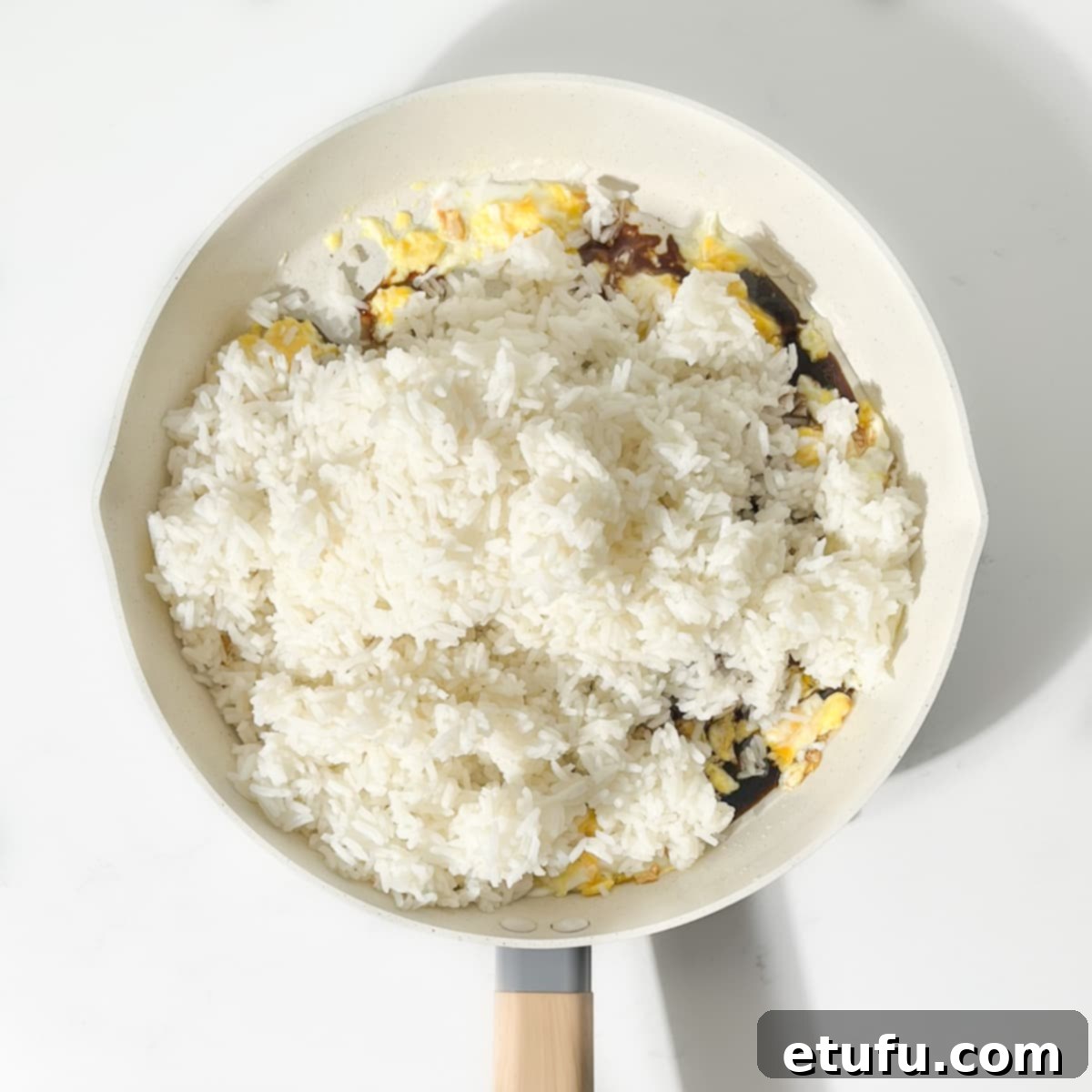

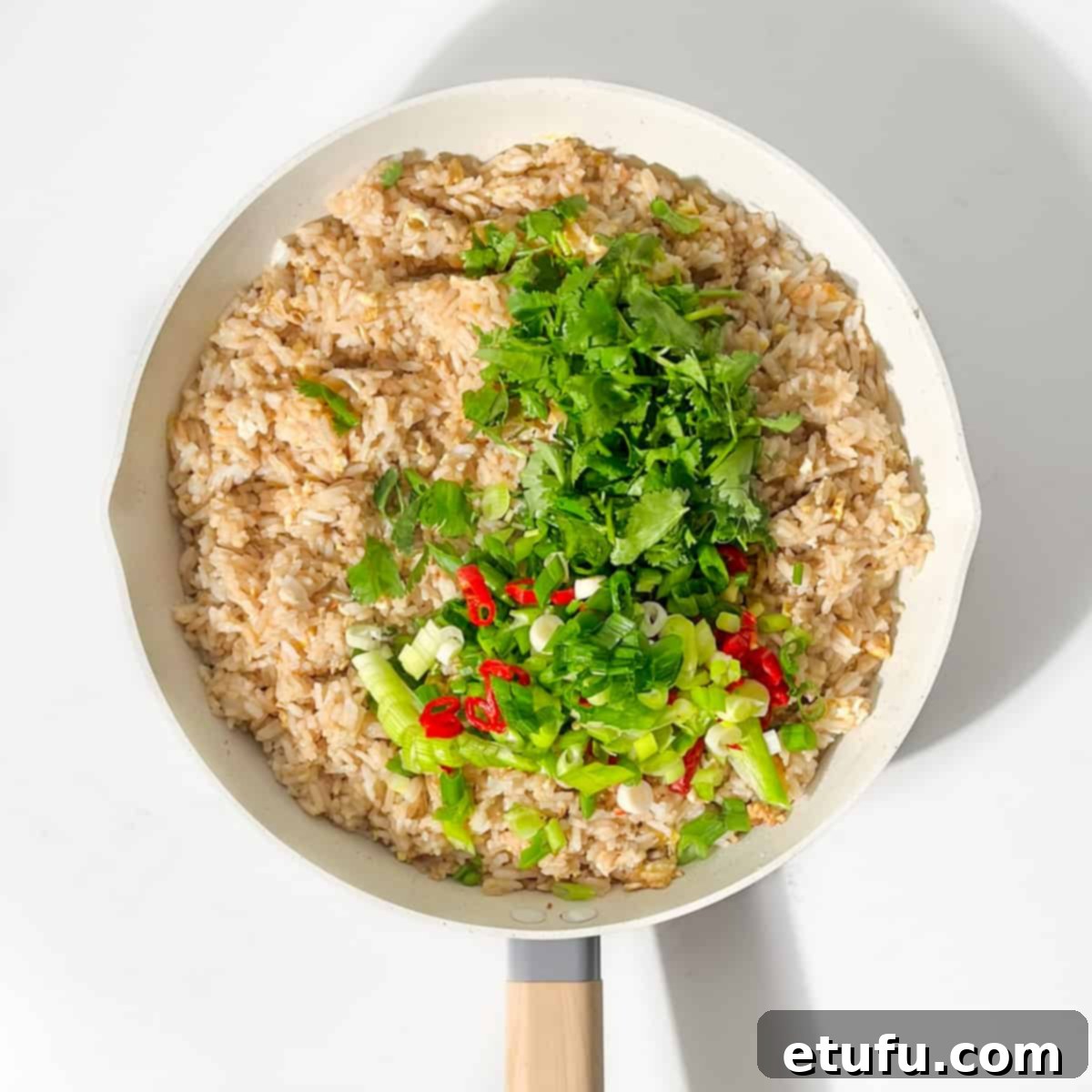
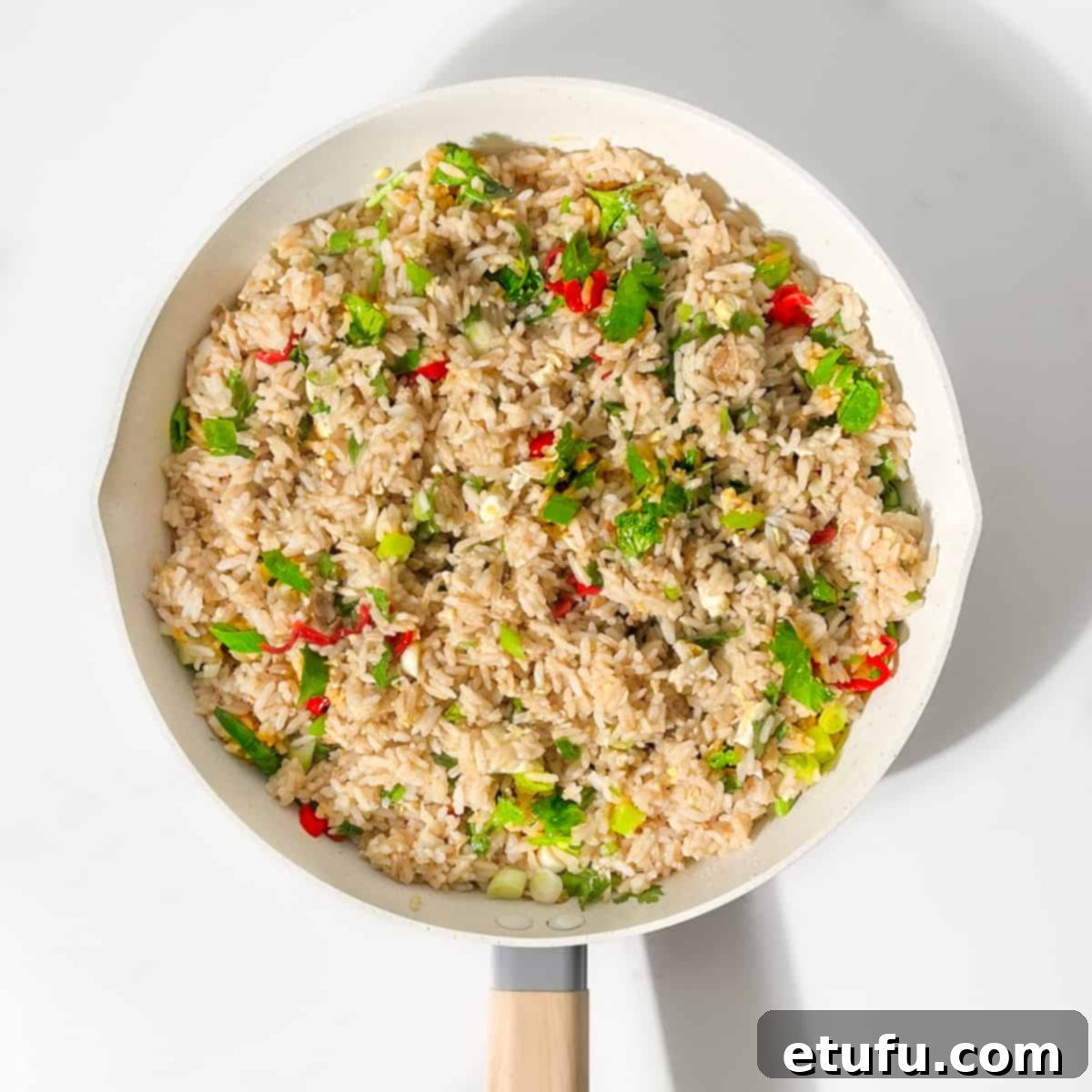
Storage and Reheating Tips for Khao Pad
Proper storage is crucial for maintaining the quality and safety of your Khao Pad, especially when dealing with cooked rice. To enjoy your leftovers safely and deliciously, follow these guidelines:
For refrigeration, transfer any leftover Khao Pad to an airtight container as quickly as possible, ideally within an hour of cooking, and refrigerate it promptly. The dish will keep well in the fridge for up to 24 hours. When reheating, you can opt for the microwave until piping hot, or re-fry it in a pan with a tiny bit of oil for a restored texture. Ensure the rice is thoroughly heated through to a safe temperature (at least 74°C or 165°F) before consuming.
If you wish to store it for a longer period, Khao Pad can also be frozen for up to three months. Again, store it in an airtight, freezer-safe container. To defrost, remove it from the freezer and let it thaw in the refrigerator for a few hours or overnight. Once defrosted, reheat using either the microwave or by re-frying in a pan until thoroughly hot. Remember, once defrosted, consume promptly and do not refreeze.
Elevate Your Khao Pad: Delicious Serving Ideas
While Khao Pad is undeniably delicious on its own, pairing it with the right accompaniments can elevate your meal to an even more authentic and satisfying experience. Here are some fantastic serving suggestions to enhance your Thai Fried Rice:
- Zesty Lime Wedges: Always serve with fresh lime wedges on the side. A squeeze of fresh lime juice just before eating brightens the entire dish, cutting through the savory richness with its vibrant acidity.
- Crisp Fresh Cucumber: Offer fresh cucumber slices or elegant long ribbons (easily made with a vegetable peeler). Their refreshing crunch and cool flavor provide a wonderful contrast to the warm, savory rice.
- Juicy Fresh Tomatoes: Slices of ripe, fresh tomatoes add a touch of sweetness and acidity, complementing the complex flavors of the Khao Pad.
- Nutrient-Rich Bean Sprouts: Toss in a handful of fresh bean sprouts just before serving for an added layer of crunch and a delicate, earthy flavor.
- Boost Your Protein: Make your Khao Pad a more substantial main course by adding your favorite protein. This can include perfectly cooked chicken strips, succulent crab meat, tender beef, fresh shrimp, or flaky pan-seared salmon. For a plant-based option, crispy pan-fried tofu is an excellent choice.
- Vibrant Added Vegetables: Enhance the nutritional value and visual appeal by incorporating other vegetables. Think thinly sliced carrots, colorful bell peppers, nutrient-rich Chinese broccoli, or tenderstem broccoli, stir-fried until crisp-tender alongside your aromatics.
- Extra Chili Kick: For spice lovers, offer extra slices of fresh chili on top just before serving. This allows each person to customize their heat level.
- Toasted Sesame Seeds: A light sprinkle of toasted sesame seeds adds a nutty flavor and a pleasing textural contrast to the dish.
- Fresh Herb Garnish: Garnish generously with fresh coriander, basil, or Thai basil leaves for a burst of vibrant color and an aromatic finish that truly captures the essence of Thai cuisine.
- Tabletop Condiments: Provide a selection of classic Thai condiments at the table. Prik Nam Pla (fish sauce mixed with fresh Thai chili), extra soy sauce, additional fish sauce, or your favorite chili sauce empower guests to adjust the flavors precisely to their taste preferences.
- Tangy Pickled Vegetables: Serve an assortment of pickled vegetables, such as cucumbers, radishes, or carrots, as a tangy and crunchy accompaniment. Their bright acidity helps to cleanse the palate and perfectly balances the rich flavors of the fried rice.
Frequently Asked Questions About Khao Pad
Is Khao Pad spicy?
The spice level of Khao Pad is entirely customizable. While our recipe includes a suggestion for chillies, using one chili typically results in a mild Khao Pad. You can easily adjust this to your taste by adding more or fewer chillies, or omitting them entirely for a non-spicy version.
How do you pronounce Khao Pad?
Khao Pad is pronounced “Kow pat.” The name itself translates directly to “stir-fried rice,” which accurately describes this delicious dish.
Is Khao Pad vegetarian?
Traditionally, Khao Pad often includes fish sauce or oyster sauce, which makes it non-vegetarian. However, it can easily be made vegetarian by simply replacing fish sauce with additional light soy sauce or opting for a vegetarian oyster sauce. Ensure all other ingredients, like any added protein, are plant-based.
Is this a healthy dish?
Yes, Khao Pad can be a very healthy and nutritious dish. It’s packed with a balanced combination of carbohydrates from the rice, protein from the eggs (and any added meat/tofu), and vitamins and minerals from the fresh vegetables and aromatics. To make it even healthier, consider using a light oil spray instead of a larger amount of vegetable oil, and load it up with extra fresh vegetables.
Can I use freshly cooked rice for Khao Pad?
While it’s possible, it’s highly recommended to use cold, day-old rice. Freshly cooked rice has too much moisture, which can make your fried rice clumpy and mushy instead of light and fluffy. If you must use fresh rice, spread it out on a tray and let it cool completely in the fridge for a few hours to dry out before stir-frying.
What kind of pan is best for making Khao Pad?
A large wok is ideal for making Khao Pad, as its high sides and curved shape allow for efficient stir-frying and even heat distribution. However, a large, heavy-bottomed frying pan or skillet will also work effectively, as long as it can get hot enough and accommodate all the ingredients without overcrowding.
Discover More Asian-Inspired Recipes
Expand your culinary horizons with these other delectable Asian-inspired dishes:
- Quick Gyoza Dipping Sauce
- Quick and Easy Spicy Sriracha Noodles
- Yuk Sung – Classic Chinese Lettuce Wraps
- Sushi Salad (Deconstructed Sushi Bowl)
- Quick and Easy Noodles with Prawns
Explore More Delicious Rice Recipes
Rice is a versatile staple around the world. Here are more rice-focused recipes to inspire your cooking:
- Fragrant Brown Rice Salad
- Creamy Coconut Basmati Rice
- Healthy Sweet Potato and Kale Salad
- Golden Yellow Rice for Bobotie (Geelrys)
Khao Pad (Thai Fried Rice) Recipe Card

Khao Pad (Authentic Thai Fried Rice)
This recipe for Khao Pad is incredibly flavorful, healthy, and exceptionally quick to prepare. It’s an ideal way to utilize leftover rice, offering a fresh, nutritious, and filling option perfect for your list of speedy weekday dinners.
Print Recipe
Ingredients
- 2 tablespoons vegetable oil
- 2 teaspoons minced garlic – roughly 3 fat garlic cloves.
- 1 teaspoon grated ginger – or finely sliced.
- 2 eggs
- 3 tablespoons light soy sauce
- 1 tablespoon oyster sauce – and/or fish sauce.
- 1 teaspoon sugar
- Few pinches white pepper (to taste) – or black pepper.
- 800 grams cooked Jasmine rice – refrigerated overnight.
- 50 grams spring onions – Finely sliced, use both green and white parts (roughly 3-4 medium spring onions).
- 2 heaped tablespoons coriander – chopped.
- 1-2 red chillies (optional) – finely sliced.
- Lime wedges for serving.
Instructions
- Measure out your sauces and have all your chopped ingredients ready. This is a fast-cooking dish, so it’s helpful to have everything at the ready.
- In a large frying pan or wok, heat the 2 tablespoons vegetable oil over medium-high heat.
- Add the 2 teaspoons minced garlic and 1 teaspoon grated ginger and fry until you see a few specks of garlic browning.
- Break the 2 eggs into the pan and let them sit for a few seconds until they just start to set a little.
- Using your spatula, break the eggs up and move them around the pan quickly to prevent sticking and too rapid browning.
- Cook the eggs until they are soft-set and avoid over-scrambling them. This should not take much longer than 30 seconds from when you broke the eggs into the pan.
- Add the 3 tablespoons light soy sauce, 1 tablespoon oyster sauce, 1 teaspoon sugar, and few pinches white pepper (to taste). Tip all the 800 grams cold, cooked rice into the pan as well.
- Still over medium-high heat and working quickly, move the rice around the pan, breaking it up and combining it with the rest of the ingredients. Stir until the rice is hot throughout.
- Remove the pan from the heat and add the 50 grams spring onions, 2 heaped tablespoons coriander, and 1-2 red chillies (optional).
- Stir your fresh additions through the rice and serve immediately with a lime wedge for serving on the side.
Notes
How much dry rice makes 800g of cooked rice?
A good rule of thumb is that dry rice triples in weight when cooked. So, you’d be looking at roughly 270g of dry rice.
Playing it safe is always a good move! Rounding up to 300g of dry rice ensures you’ve got a little extra wiggle room. Whether you end up with a bit over or under 800g of cooked rice, don’t worry, it won’t throw off the recipe much.
**Nutritional data disclaimer**
Please keep in mind that the nutritional information provided below is calculated by a third party, and we cannot guarantee its absolute accuracy. We strive to provide the most precise information possible, but we do not take responsibility for any potential errors. Additionally, the nutritional value of this recipe may vary depending on the exact brands and products used. We recommend consulting with a qualified healthcare professional or registered dietitian for personalized advice tailored to your dietary needs.
Nutrition
Carbohydrates: 62g |
Protein: 10g |
Fat: 10g |
Saturated Fat: 2g |
Polyunsaturated Fat: 5g |
Monounsaturated Fat: 3g |
Trans Fat: 0.1g |
Cholesterol: 82mg |
Sodium: 926mg |
Potassium: 217mg |
Fiber: 2g |
Sugar: 2g |
Vitamin A: 351IU |
Vitamin C: 19mg |
Calcium: 53mg |
Iron: 2mg
For comprehensive food safety advice, including detailed guidance on food allergies and safe handling practices, please refer to official food safety authorities.
